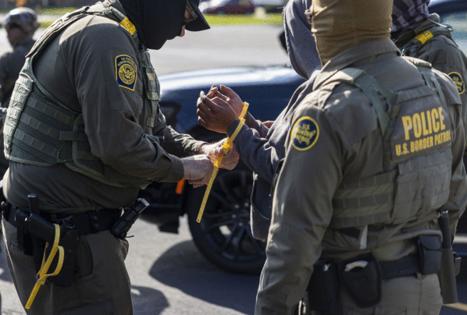Only 2.6% on list of 614 'Operation Midway Blitz' arrestees had criminal histories, DOJ records show
Published in News & Features
CHICAGO — The Trump administration on Friday released the names of 614 people whose Chicago-area immigration arrests may have violated a 2022 consent decree, and only 16 of them have criminal histories that present a “high public safety risk.”
The list was produced as part of an ongoing lawsuit alleging immigration agents have repeatedly violated the terms of the in-court settlement, mostly during “Operation Midway Blitz,” that puts a high bar on making so-called warrantless arrests without a prior warrant or probable cause.
The Department of Homeland Security has claimed since the outset of the operation that they were going after the “worst of the worst,” including convicted murderers, rapists and other violent offenders who were allegedly taking advantage of Illinois’ sanctuary policies to terrorize the citizenry.
But the government’s own data, provided in a filing posted to the public docket Friday, appeared to show otherwise. Of the 16 arrestees with criminal histories — or about 2.6% of the 614 people — five involved domestic battery, two were related to drunken driving, and one allegedly had an unidentified criminal history in another country.
One person was deemed a national security risk, another had a narcotics conviction, and five more had been accused of various forms of battery, including two involving guns, the records indicated.
No one had any convictions for murder or rape.
Meanwhile, the other 598 people on the list had no listed criminal history at all. Some were still classified by the DHS has a “medium” or “high” security risk for reasons unexplained.
The people on the list were all arrested by agents with U.S. Immigration and Customs Enforcement prior to Oct. 7. In the coming weeks, the government was expected to produce a much lengthier list of more than 3,300 arrestees, including those arrested by Border Patrol later on in the operation.
The list was produced by order of U.S. District Judge Jeffrey Cummings, who said he will grant a $1,500 bond to anyone who is still in custody in the U.S. and who is not confirmed by the government to be a safety risk or subject to a prior removal order.
Cummings said he’d also order some form of monitoring of the arrestees, including electronic ankle monitors, pending the outcome of immigration proceedings. Most of those arrested were originally processed at the ICE processing center in west suburban Broadview, but have since been moved to jails around the country.
Cummings also ordered the release of 13 other arrestees no later than Friday because the Department of Justice was not claiming they were a security risk. An update on whether they had been released as ordered was not immediately available.
A spokesperson for the DHS was not immediately available for comment.
Mark Fleming, the lead attorney in the lawsuit that led to the consent decree, declined to comment.
Meanwhile, Cummings’ decision will ultimately affect a much wider segment of the thousands of arrests made by ICE and U.S. Border Patrol in Chicago since the Trump administration’s enhanced immigration-enforcement operations.
So far, the government has identified more than 3,300 such arrests, the vast majority of which plaintiffs’ attorneys believe will prove to be unlawful.
In explaining his decision on Wednesday, Cummings read from a summary he and his law clerks compiled from more than 150 ongoing immigration petitions in federal court, where arrestees were challenging deportation. He said the circumstances of the arrests showed him that, by and large, Operation Midway Blitz was not targeting hardened criminals.
Of them, Cummings said, 54 people were arrested while at work, including 20 landscapers, four Uber or taxi drivers, and two street vendors. Another 20 were arrested while commuting to or from work, and nine were detained at a Home Depot or Menards, where they were presumably either seeking work or buying job supplies, the judge said.
Six were arrested “outside their home or a friend’s or relative’s home,” he said. Seven people were arrested at immigration hearings or appointments, and another 11 in public places such as shops, grocery stores, and even “a Dunkin’ Donuts drive-thru,” Cummings said.
“It is highly unlikely any of them are criminal gang members, drug traffickers or assorted ne’er-do-wells who fall under the category of what ICE has called ‘the worst of the worst,’” Cummings said.
The development in court comes amid litigation over whether immigration officials have violated a consent decree restricting warrantless arrests.
Plaintiffs defending those who have been arrested have accused federal officials of repeatedly breaking the terms of the consent decree and asked that Cummings issue a blanket order releasing most of the detainees on ankle monitoring. The government, meanwhile, said plaintiffs were trying to “paint with a broad brush” and that the validity of detaining someone should be evaluated on a case-by-case basis.
Known as the Castañon Nava settlement agreement, the consent decree issued during the Biden administration bars agents from making warrantless immigration arrests unless they have probable cause to believe someone is in the U.S. unlawfully and that the person is a flight risk.
It was originally supposed to sunset in March. Instead, after the Trump administration began ramping up immigration enforcement efforts in January, lawyers for the National Immigrant Justice Center and ACLU alleged dozens of violations, mostly involving “collateral arrests,” or the detaining of individuals who are not targets.
In his Oct. 7 order extending the consent decree until February, Cummings said ICE had improperly told its field offices over the summer that the consent decree had been canceled. He also called into question the recent immigration raid on an apartment building in South Shore, where agents in military gear burst through doors and zip-tied residents regardless of citizenship.
And the judge also took particular issue with a practice by ICE agents of carrying blank I-200 warrant forms with them on missions and filling them out at the scene.
_____
©2025 Chicago Tribune. Visit chicagotribune.com. Distributed by Tribune Content Agency, LLC.







Comments